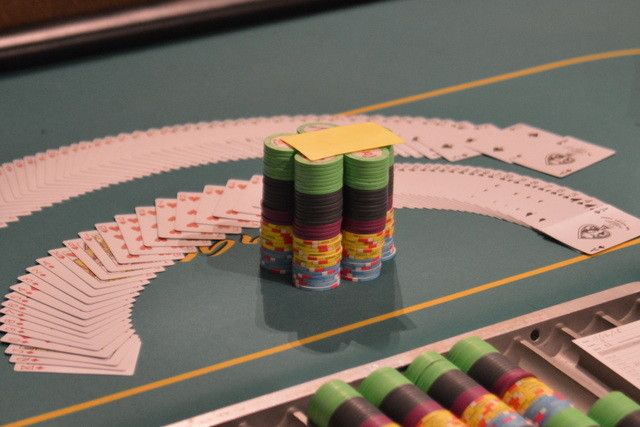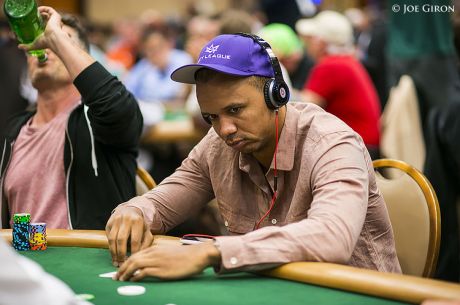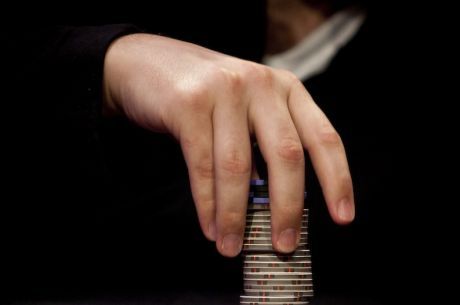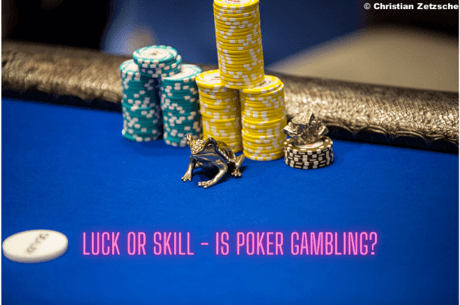Poker Straddle Explained - What is a Straddle in Poker?

Straddling in poker might sound complex, but it's a simple concept. Analysing whether or not you should straddle and how to play against the straddle, however, are completely different stories. So, in this article our resident poker expert will explain everything you need to know about the straddle, including what it is and how to play against it.
What is a Straddle in Poker?
A straddle in poker is an optional blind bet a player makes before the cards are dealt. It is usually twice the size of the big blind and allows the straddling player to act last preflop. It increases the stakes and creates more aggressive play in the following betting rounds.
Straddling can only take place in poker cash games and is not something you can do in poker tournaments. If you didn't know, you can also straddle when playing online poker cash games on sites like TigerGaming.
The number of variations on that basic idea is daunting and bewildering to every new player. You can hit five Vegas poker rooms in a day and find that they all have different straddle rules.
Explaining the Straddle in Poker
Let's start by describing the basic elements of what we might call the "classic" straddle in poker:
- It occurs in "flop" games or the versions of poker in which all players use community cards to make their hands �� mainly Texas hold'em and Omaha poker.
- The option to place a straddle bet belongs to the player who would otherwise be first to act, which is the seat to the immediate left of the big blind.
- The straddle bet, if it is to be done, must be either put out or verbally announced before the cards are dealt, or at least before the player has looked at his cards. (The former way is easier to enforce, but some casinos allow the latter.)
- The size of the straddle bet is double the big blind and effectively acts as a voluntary third blind, by which I mean that it sets a new "limp-in" level. In a $1/$2 no-limit hold'em game, the straddle would be $4. Subsequent players, in turn must either call that $4, raise, or fold. In essence, for one hand the straddle transforms the game from $1/$2 no-limit to $1/$2/$4 no-limit.
- Because the straddler put his money in without having seen his cards, he is given another chance to act after having looked at them, just as the two players in the blinds get. His options are the same as those that the big blind has when there is no straddle: check, fold, or raise, depending on what action has gone before.
- After the flop, everything proceeds normally; the fact that there was a preflop straddle has no further effect on how the hand is played.
All of that is not too hard to deal with.
You just think of the straddle as an optional third blind, and everything makes perfect sense.
But poker players are never content just to leave well enough alone. They're always tinkering, coming up with new variations to keep from getting bored and to try to find a new strategic edge.
So, we started seeing mutations of the basic elements listed above. And these can change the very nature of this bet and the poker straddle definition.
Play online poker games on the top online poker sites of 2023 and join thousands of other players in exciting games of Texas Hold'em, Omaha, and more!
The Straddle Bet in No-Limit Games
In no-limit games, some people reasoned that the "no-limit" concept should apply to all bets, including the straddle.

As a result, you now sometimes see house rules that allow the straddle to be any amount, up to and including an all-in blind bet. Action-hungry players love this.
Other more conservative players think it ruins the game, turning a contest of skill into a crapshoot when the game has a few players who take advantage of this leeway.
If you ask me, I'm delighted to have a game in which we have players routinely putting in all their chips in the dark.
That's because:
- I am not one of them
- I get to decide whether to call after looking at my cards.
If you think about it, this way of using the straddle bet in poker is an enormous advantage in my favour �� a far larger mathematical edge than I could get in most games.
Besides, action like that doesn't tend to go on for very long.
The players doing it either burn through all the money in their pocket, or they get lucky, accumulate a huge stack, and decide to either cash-out or start playing more cautiously.
Poker Straddle: Three Scenarios to Know
There are different scenarios where you might be required to know how to deal with straddling and how to size your first bet.
- The Under-the-Gun (UTG) Straddle: This is the most common straddle in poker. The UTG player is required to place the straddle bet before the dealer begins to distribute the cards.
- The Mississippi Straddle: Any player can straddle �� as long as they do it before the cards are dealt. If no one re-straddle (yes, that's possible), the player who places the straddle bet is the last one to act before the flop.
- The Un-Capped Straddle: This is the occasion we have seen above when we spoke about no-limit games. This type removes the 2x BB rule and lets players bet as much as they want / can afford.
The "Button Straddle" in Poker
The button straddle in poker is when the player on the dealer button voluntarily posts a straddle bet before the cards are dealt.
What is a Button Straddle in Poker?
In poker, the button straddle refers to the act of a player on the dealer button voluntarily placing a straddle bet before the cards are dealt.
This bet, usually double the big blind, grants the straddling player the final preflop action, intensifying the game with higher stakes and more aggressive play possibilities.
How Does the Button Straddle Affect Position in Poker?
The button straddle in poker significantly affects position dynamics during gameplay. By voluntarily posting a straddle bet, the player on the dealer button assumes a unique position advantage. This action grants them the last preflop action, allowing them to act after all other players have made their decisions. Consequently, the button straddle expands the preflop betting range, encouraging more aggressive plays and increasing the pot size.
Even in post-flop play, the button straddler continues to have the positional advantage, as they will still act last in subsequent betting rounds.
Pros and Cons of a Straddle Bet in Poker
Straddling in poker has its merits and drawbacks. Exploring the advantages and disadvantages can help players make informed decisions during gameplay.
What are the Pros of Straddling in Poker?
People choose to straddle in poker for a variety of reasons. Here are a few common motivations:
- Increasing Action: Straddling is often done to liven up the game and generate more action. By adding a third blind, the pot size increases, which can entice players to play more hands and create a more exciting atmosphere at the table.
- Exploiting Tight Games: In games where players are generally conservative or tight, a straddle can serve as a way to loosen up the action and encourage opponents to play more hands. It can be a strategic move to take advantage of the players' reluctance to participate in large pots.
- Gaining Positional Advantage: By straddling, a player can effectively buy the positional advantage by being the last to act pre-flop. This can provide them with more information about their opponents' actions before deciding how to proceed with their hand.
- Psychological Warfare: Straddling can be used as a psychological tactic to disrupt opponents' strategies and force them to adjust. It can create confusion, pressure opponents' stacks, and potentially lead to suboptimal decisions.
- Social or Recreational Reasons: Players sometimes straddle simply because it's a common practice among their group or at the casino they're playing in. It may be seen as a fun or recreational aspect of the game that adds an extra element of excitement.
What are the Cons of Straddling in Poker?
- Increased Financial Risk: Straddling requires a higher initial investment, exposing players to greater financial jeopardy if the hand goes awry or opponents outplay them.
- Diminished Hand Value: With more players enticed by the straddle, strong hands lose their relative strength, reducing the advantage of premium holdings.
- Loss of Positional Advantage: Post-flop, straddlers often act first, relinquishing the benefits of a later position for controlling the betting action.
- Encourages Aggressive Play: Straddling can provoke opponents to play more aggressively, increasing the intensity and unpredictability of the game.
- Disrupted Strategy: Straddling alters the standard game dynamics, potentially disrupting a player's strategy and making it harder to read opponents effectively.
When Should You Straddle in Poker?
Deciding when to straddle in poker is a strategic choice that can impact the game's dynamics. Consider the following scenarios to help determine if straddling is appropriate:
- Deep Stack Play: Straddling can be more viable with deep stacks, as the increased blind bet is a smaller percentage of the overall stack.
- Table Dynamics: If opponents are tight and cautious, a straddle can introduce more action and opportunities to exploit their tendencies.
- Aggressive Image: If you have a loose-aggressive image, a straddle can enhance your table image, potentially inducing opponents to make mistakes against you.
- Late Night/Recreational Games: In casual games or late-night sessions, straddling may be more accepted, and players might be looser with their play.
- Bankroll Consideration: Straddling involves higher risk, so ensure your bankroll can handle potential swings.
- Home Game Fun: Straddling can add excitement to friendly home games, enhancing overall enjoyment.
However, in more serious or professional games, straddling may not be as advantageous. It can expose players to unnecessary risk and disrupt established strategies. Always assess the table, your stack size, and the overall game atmosphere before deciding to straddle, ensuring it aligns with your overall poker objectives.
Players will often advise against straddling in poker, especially if you're new to the game. Here are some other things you should never do at the poker table.
What do Players Think about the Straddle Bet?
| Players | Reaction |
|---|---|
| Aggressive Players | In Favor. You get more action when the straddle bet can lead to an all-in blind bet. |
| Conservative Players | Against. When you don't set a limit for the straddle bet in no-limit poker games, you risk turning the hands into a luck-based lottery. |
Poker Straddle F.A.Q.
Why do you straddle in poker?
You straddle in poker to increase action, exploit opponents' tight play, enhance your table image, or in relaxed home games for added excitement.
Is the straddle considered to be a raise?
The straddle is a third blind, not a raise. However much the straddle is, that's the new big blind.
How much can you straddle in poker?
The standard straddle bet is equal to 2x the big blind (BB). In a $1/$2 Hold'em game, the straddle would be $4. Once the straddle bet is on the table, all the other players will need $4 to 'Call' and continue playing the hand.
Is straddling profitable in poker?
Straddling in poker is rarely profitable. The straddle is a blind bet, and it is never +EV to invest in your hand before you see what cards you hold.
Does PokerNews recommend straddling in poker?
On the whole, we do not recommend straddling in poker. If you are experienced and if you are very comfortable with all the dynamics of a cash game, then you can straddle if you want to, but we'd advise to not include straddling in your strategy if you want to be profitable in the long run.









